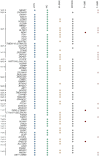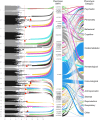This is a preprint.
Genome-wide association study of major anxiety disorders in 122,341 European-ancestry cases identifies 58 loci and highlights GABAergic signaling
- PMID: 39006447
- PMCID: PMC11245051
- DOI: 10.1101/2024.07.03.24309466
Genome-wide association study of major anxiety disorders in 122,341 European-ancestry cases identifies 58 loci and highlights GABAergic signaling
Abstract
The major anxiety disorders (ANX; including generalized anxiety disorder, panic disorder, and phobias) are highly prevalent, often onset early, persist throughout life, and cause substantial global disability. Although distinct in their clinical presentations, they likely represent differential expressions of a dysregulated threat-response system. Here we present a genome-wide association meta-analysis comprising 122,341 European ancestry ANX cases and 729,881 controls. We identified 58 independent genome-wide significant ANX risk variants and 66 genes with robust biological support. In an independent sample of 1,175,012 self-report ANX cases and 1,956,379 controls, 51 of the 58 associated variants were replicated. As predicted by twin studies, we found substantial genetic correlation between ANX and depression, neuroticism, and other internalizing phenotypes. Follow-up analyses demonstrated enrichment in all major brain regions and highlighted GABAergic signaling as one potential mechanism underlying ANX genetic risk. These results advance our understanding of the genetic architecture of ANX and prioritize genes for functional follow-up studies.
Conflict of interest statement
Per Hoffmann receives Salary from the Life & Brain GmbH, Bonn, Germany. James L. Kennedy is a member of the Scientific Advisory Board for Myriad Neuroscience Inc. Ian B. Hickie was an inaugural Commissioner on Australia’s National Mental Health Commission (2012-18). He is the Co-Director, Health and Policy at the Brain and Mind Centre (BMC) University of Sydney. The BMC operates an early-intervention youth services at Camperdown under contract to headspace. He is the Chief Scientific Advisor to, and a 5% equity shareholder in, InnoWell Pty Ltd. InnoWell was formed by the University of Sydney (45% equity) and PwC (Australia; 45% equity) to deliver the $30 M Australian Government-funded Project Synergy (2017-20; a three-year program for the transformation of mental health services) and to lead transformation of mental health services internationally through the use of innovative technologies. Andrew M. Mcintosh has received research support from Eli Lilly, Janssen, and The Sackler Trust. AMM has also received speaker fees from Illumina and Janssen. Murray B. Stein has in the past 3 years received consulting income from Acadia Pharmaceuticals, Aptinyx, atai Life Sciences, Boehringer Ingelheim, Bionomics, BioXcel Therapeutics, Clexio, Eisai, EmpowerPharm, Engrail Therapeutics, Janssen, Jazz Pharmaceuticals, and Roche/Genentech. Dr. Stein has stock options in Oxeia Biopharmaceuticals and EpiVario. He is paid for his editorial work on Depression and Anxiety (Editor-in-Chief), Biological Psychiatry (Deputy Editor), and UpToDate (Co-Editor-in-Chief for Psychiatry). He has also received research support from NIH, Department of Veterans Affairs, and the Department of Defense. He is on the scientific advisory board for the Brain and Behavior Research Foundation and the Anxiety and Depression Association of America. Joel Gelernter is named as an inventor on PCT patent application #15/878,640 entitled: “Genotype-guided dosing of opioid agonists,” filed January 24, 2018 and issued on January 26, 2021 as U.S. Patent No. 10,900,082; and is paid for editorial work for the journal “Complex Psychiatry.” Iiris Hovatta received speaker’s honoraria from Lundbeck. Ole A. Andreassen received speaker’s honorarium from Lundbeck and Sunovion, consultant for Cortechs.ai and Precision Health AS. Katharina Domschke has been a member of the Steering Committee Neurosciences, Janssen, Inc. until 2022 and is currently a member of the Board of the German National Society of Psychiatry (DGPPN) and the Neurotorium Editorial Board of the Lundbeck Foundation. Jordan W. Smoller is a member of the Scientific Advisory Board of Sensorium Therapeutics (with equity) and has received an honorarium for an internal seminar Tempus Labs. He is PI of a collaborative study of the genetics of depression and bipolar disorder sponsored by 23andMe for which 23andMe provides analysis time as in-kind support but no payments. Eduard Maron has received research support and has also received speaker fees from Lundbeck. Hans J. Grabe has received travel grants and speakers honoraria from Indorsia, Neuraxpharm, Servier and Janssen Cilag. Henrik Larsson has served as a speaker for Evolan Pharma, Medici and Shire/Takeda and has received research grants from Shire/Takeda; all outside the submitted work. Gerome Breen is an advisory board member for Compass Pathways. Jürgen Deckert is a member of the board of the German Society of Biological Psychiatry and is on the scientific advisory boards of non-profit organizations and foundations. Volker Arolt worked as an advisor for Sanofi-Adventis Germany. Zach Fuller and Xin Wang are employees of 23andMe and hold stock or stock options in 23andMe. All other authors have no competing interests to declare.
Figures





References
-
- Ask H, Cheesman R, Jami ES, Levey DF, Purves KL, Weber H (2021): Genetic contributions to anxiety disorders: where we are and where we are heading. Psychol Med 51: 2231–2246. - PubMed
Publication types
Grants and funding
- T32 GM080178/GM/NIGMS NIH HHS/United States
- R01 DA024413/DA/NIDA NIH HHS/United States
- EP-C-15-001/EPA/EPA/United States
- R01 DA054313/DA/NIDA NIH HHS/United States
- U01 HG006378/HG/NHGRI NIH HHS/United States
- U01 MH109528/MH/NIMH NIH HHS/United States
- R01 AA013320/AA/NIAAA NIH HHS/United States
- RC2 MH089951/MH/NIMH NIH HHS/United States
- R01 MH124851/MH/NIMH NIH HHS/United States
- R01 MH118239/MH/NIMH NIH HHS/United States
- UL1 TR000445/TR/NCATS NIH HHS/United States
- R01 AA007535/AA/NIAAA NIH HHS/United States
- K23 MH080230/MH/NIMH NIH HHS/United States
- R01 AA014041/AA/NIAAA NIH HHS/United States
- R01 MH081802/MH/NIMH NIH HHS/United States
- R01 MH066206/MH/NIMH NIH HHS/United States
- IK2 BX005058/BX/BLRD VA/United States
- R25 MH101076/MH/NIMH NIH HHS/United States
- RC2 MH089995/MH/NIMH NIH HHS/United States
- R01 MH063970/MH/NIMH NIH HHS/United States
- ZIA MH002843/ImNIH/Intramural NIH HHS/United States
- U19 HL065962/HL/NHLBI NIH HHS/United States
- K25 AA030072/AA/NIAAA NIH HHS/United States
- UL1 TR002538/TR/NCATS NIH HHS/United States
- R01 HD042157/HD/NICHD NIH HHS/United States
- R01 MH077874/MH/NIMH NIH HHS/United States
- S10 RR025141/RR/NCRR NIH HHS/United States
- R01 AA013326/AA/NIAAA NIH HHS/United States
- U01 DA024413/DA/NIDA NIH HHS/United States
- R56 DA012854/DA/NIDA NIH HHS/United States
- R01 MH068521/MH/NIMH NIH HHS/United States
- R01 MH124847/MH/NIMH NIH HHS/United States
- R01 AA013321/AA/NIAAA NIH HHS/United States
- R01 MH123489/MH/NIMH NIH HHS/United States
- I01 CX001849/CX/CSRD VA/United States
- R01 HD093651/HD/NICHD NIH HHS/United States
- R01 DA025109/DA/NIDA NIH HHS/United States
- U01 MH109514/MH/NIMH NIH HHS/United States
- R01 HD074711/HD/NICHD NIH HHS/United States
- RC2 GM092618/GM/NIGMS NIH HHS/United States
- U24 MH068457/MH/NIMH NIH HHS/United States
- R01 DA012854/DA/NIDA NIH HHS/United States
- P50 GM115305/GM/NIGMS NIH HHS/United States
- K01 MH093731/MH/NIMH NIH HHS/United States
- R00 DA023549/DA/NIDA NIH HHS/United States
- K08 DA019951/DA/NIDA NIH HHS/United States
- R01 MH113665/MH/NIMH NIH HHS/United States
- UL1 RR024975/RR/NCRR NIH HHS/United States
- WT_/Wellcome Trust/United Kingdom
- R01 DA011301/DA/NIDA NIH HHS/United States
- R01 NS032830/NS/NINDS NIH HHS/United States
- R01 MH122412/MH/NIMH NIH HHS/United States
- U01 HG004798/HG/NHGRI NIH HHS/United States
- UL1 TR002243/TR/NCATS NIH HHS/United States
- R01 MH125938/MH/NIMH NIH HHS/United States
- R01 MH048085/MH/NIMH NIH HHS/United States
- R01 MH063671/MH/NIMH NIH HHS/United States
- R01 MH085542/MH/NIMH NIH HHS/United States
- P30 CA042014/CA/NCI NIH HHS/United States
- R01 MH123619/MH/NIMH NIH HHS/United States
LinkOut - more resources
Full Text Sources
Research Materials
